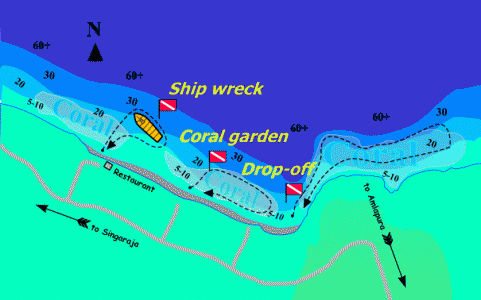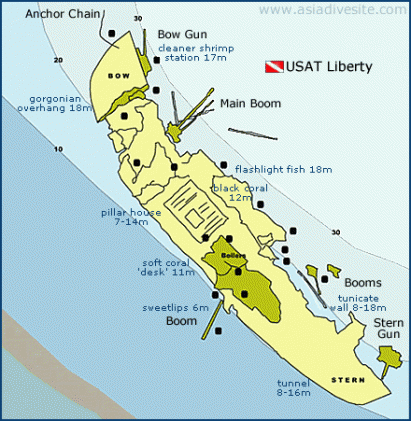Tulamben
Tulamben is a little village in the northeast coast of Bali, the beach is black sand covered by smooth, fist-size rocks. It remains of Gunung Agung exploding in 1963 has sent the lava flows along this coastal area. There is a bay here that invites divers to visit this village to explore under water scene. The bay was later known as Tulamben Bay amongst the divers. The excellent diving sites in this bay are Ship Wreck (UST Liberty Cargo),Paradise Reef and Drop Off (actually rugged wall). These sites are the best beach entry scuba diving in all of Bali, further east about 15 minutes is cruising in a small out trigger fishing boat, will bring you to other diving sites known as Alamanda reef and Batu Kelebit. A car ride 10 minutes further west of Tulamben and you will be in Kubu village with its beach similar in condition to Tulamben Bay offers a diving on the pristine Kubu reef.
1. Ship wreck ( UST Liberty Cargo )
Just 30 meters from the beach at Tulamben is a World War I-era cargo ship broken up but still an impressively large wreck, stretching 120 meters long on steeply sloping sandy bottom. The top of wreckage is just 3 meters water and the bottom is at 29 meters. January 11th, 1942, this ship was hit by torpedoes from a Japanese submarine while crossing the Lombok Strait carried rubber and railroad part on World War II service. The damage was critical, but two destroyers hitched up to the ship and tried to tow it to the port at Singaraja. The wounded cargo ship was taking too much water, however her crew ran the vessel up on the beach at Tulamben. The volcanic explosion of Gunung Agung in 1963 rolled Liberty off the beach to its present location, in the process breaking in pieces. The wreck is completely covered with variety of corals and inhabitat of hundreds of species of fish, an Australian Rudie Kuiter, author of the definitive guide to Indonesian reef fishes, estimates that some 400 species of reef fishes live on the wreck, which is also visited by perhaps 100 species of pelagic. This is a remarkable number for an area just 120 meters long. On the slack tide is a good time to do night dive, remarkable flashlight fishes (Anomalops katoptron) in the black corals at the bow blink the light like stars light in the sky. Visibility is average 15 to 20 meters and water temperature is roughly warm 28 C to 29 C.
2. Paradise Reef
The name of this reef has been taken from the hotel is standing on the beach, Paradise Hotel. This shallow patch reef is delightfully richly covered no more than 200 meters long and lies in 5 to 15 meters of water. This reef is dominated by Acropora, hard corals, some large table corals and Fire corals, there are also large Clownfish Anemones, Crinoids, Leather corals and bushy of Hydroids and supports diversity of fish population in this area, Parrotfish, Wrasse, Snappers and the rest of other marine fish, as well as rarities like Ribbon ells, Frogfish and unusual Scorpionfish. Past the patch reef down the slope is a rubble sandy bottom at 20 to 35 meters, in a single Crinoids feather star is sometimes a pair of Ornate Ghost Pipefish found with many other unusual and weird critters, like Steene’s Dotty Backs (Pscudochromis Steene) bright orange face with spiky teeth and pushed lower jaw and variety of Nudibranchs. Photographers and divers who like macro sea life this is a favourite site to discover and experience unusual animals. For night dive this is a very convenient location due its position close to main resort at Tulamben.
3. Drop Off ( Rugged Wall )
The local of Tulamben calls this reef “Drop Off”, it is actually rugged wall reef stretching out seaward, and the reef wall descends down over 70 meters. Black corals, soft corals and hard corals grow well on the crannies and overhangs at around 18 meters, there live an abundance of Cleaner Shrimps and large fishes are waiting in overhangs to be cleaned. The hook of the wall at 28 meters where the reef extends to the sloping eastern reef stands a huge purple sea fan Gorgonian, over 2 meters wide this is a sticking land mark on the reef wall. A prolific variety of schooling fishes swim around the corner of the wall, pick up Planktons brings in with the current, and even invertebrate animals often encounter at this rugged wall reef. At shallow crannies reef is delightful rich with a marine life. Flashlight fish (Photoblepharon palpebratus) during night dive is remarkable scene on bushy black corals at the overhang of the wall. The current normally runs north, as the beach entry we have to think to travel back with the ample air in the tank, the Divemaster or Instructor will assist with this problem. Water temperature is always warm roughly 28 C to 29 C underwater.
4. Alamanda Reef
Pick up a small wooden local outrigger fishing boat to cruise after Drop Off is healthy Alamanda Reef. Crannies steep slope reef is dominated by dome hard corals, soft corals and variety of Gorgonians, below 20 to 30 meters is rich ridged reef with large number of sponges, Barrel sponges, variety of reef fishes, Pygmy Seahorse on purple sea fan is favourite macro critter amongst the experienced divers, sometime on a single seafan you can find 5 to 10 Pygmys. Current mainly brings the diver toward the Drop Off, water temperature is warm and good visibility, and it makes a great drift diving with the boat is waiting at the end of your dive.
5. Batu Kelebit Reef
Batu Kelebit Reef. Is named after the local fishermen, literally the Kelebit Rocks, are two large underwater boulders lying just offshore, one of two pointed jagged crest of lava is always submerged, the other point is crusted by water used as a marker for the diving area. Sand channel between two reef ridges is covered by fire corals leading to the reef edges at 25 to 40 meters, which are rich and healthy reef is covered with an extremely diverse growth of hard corals, sponges, gorgonians and every other encrusting animals are possible to encounter. The current runs toward north, sometime strong but mostly mild brings planktons that accumulated at the reef edges, inviting larger pelagic animals to appear like White-Tip Reef Sharks, schools of Jacks, Dogtooth Tuna and even Sunfish. Water clarity is always good and its temperature is a bit cooler compared to the rest of Tulamben bay dive sites. From Tulamben bay is cruising with a small wooden local outrigger fishing boat takes about 15 minutes to this site.
6. Kubu reef
It’s located in the little village of Kubu, about 3 Km from Tulamben bay. The minibus will stop right at the top edge of beach -volcanic rocks beach-, at its front there is gorgeous reef submerged offshore. After the scuba gear assembled on the beach, enter the water directly in front of the reef and begin your exploration. The reef stretches from 5 meters down the slope to over 30 meters, large number of Hydroids are growing at the beginning of the reef, Sponges, soft corals, short hard corals and many huge seafans offer an ideal place for the Pygmy Seahorses to shelter. You can find plenty of reef fishes, beside large pelagic fishes, White-Tip Shark and the occasional big Trevally. Current is usually mild, but it can be strong and makes the visibility is blur because of the bottom is stirring up. There is no difference of water temperature to Tulamben bay is roughly 28 to 29 C.


